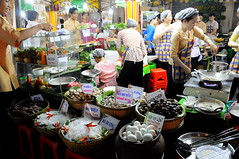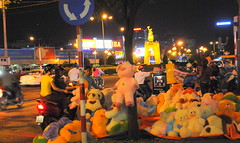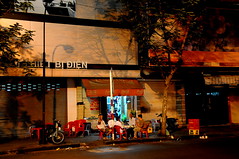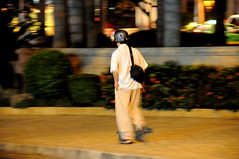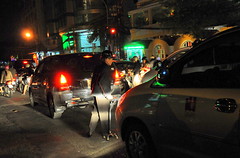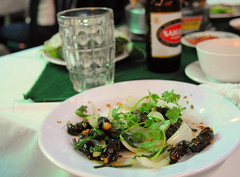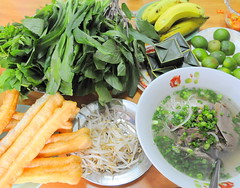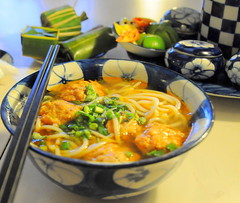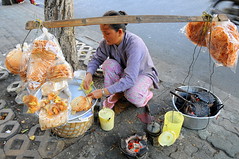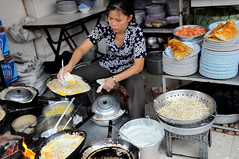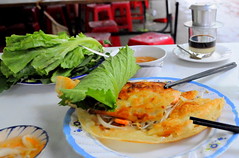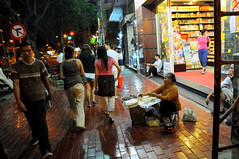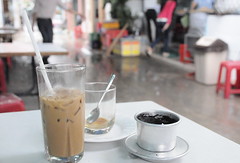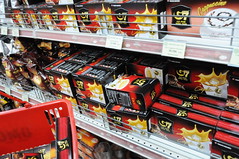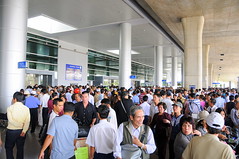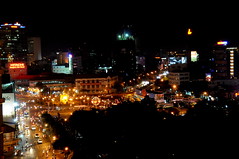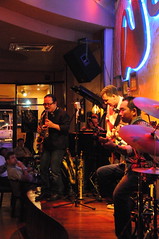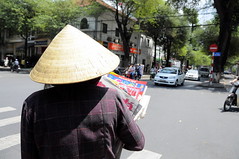Supping in Saigon, Fear Factor-style
The first time I was in Ho Chi Minh City, we rented a cheap room in Pham Ngu Lao - the sole bedroom, it seemed, of the landlady's family. At night, the family, their dogs, their motorcycles and the flickering telly kipped in the living room.
We used to pass New World Hotel, Saigon during the long walk to civilisation and marvel at its lack of exterior beauty. Nevertheless, almost half a decade later, a suite in the New World Hotel was great, not for its Marriot-management, king-sized bed, 2 bathrooms, 2 tellies, living room, Grohe taps, Thann-inspired toiletries, deluxe breakfasts, all-day executive buffet, free flow of alcohol nor personalised service (the globalised needs, apparently, of business travellers), but for its proximity to the Ben Thanh Market.
Being within spitting distance meant that when the endless black words crawled like armies of ants over stacks of papers and out the window into the darkness, after late-night conference calls and meetings, a hot supper was just five minutes away.
There was nothing better than to jettison the sterility of board rooms and blanched smell of ink and sour coffee to bathe in the smoke of enormous grills of meat and seafood spitting on hot coals, inhale plates of goi cuon, sip bia hoi and Saigon Beer and 333 and listen to the curbside chatter.
There is a symbiotic relationship between lives lived out on the street and the prevalence of motorcycles. It is a relationship of convenience and theft-prevention, intimacy and casualness. A motorcycle can pull up by a roadside store to check out the goods or nosh on some grub before motoring off again, saving on time, parking expenses for parking in a covered giu xe and losing their motorcycle kidneys to the parking attendants in al fresco parks. Even where proper shops have sprung up, motos park right up at the counter. It remains to be seen if growing affluence will affect private transportation choices and if an increase in the use of cars will affect the general social laissez-faire-ness of the people.
The most recent obvious change to the general lives of motorcyclists however, has been the helmet law. All about town, people are now zooming about togged in shiny new headgear, which, said the government proudly, has already helped to cut down motorbike-related injuries.
Taking the safety message to heart, pedestrians have been spotted with helmets on their noggin, crossing streets. A full set of armour might protect against HCMC's traffic but a helmet's a start, I suppose. Many reasons have been proposed for this trend: convenience (they used to wear caps now they just wear helmets), time-saving, theft-prevention. Fashion-conscious Bangkok, Vietnam is not.
Foodstakes-wise however, this Saigon trip won hands-down over the bottom-drawer Bangkok one earlier this month. The suite didn't come with a kitchenette to put into use whatever skills were gained at Vietnam Cookery Centre. But then it was so effortless to fork over less than S$5 for good street grub.
Handshakes and smiles all around one evening meant a pleasant walk to Luong Son for bo tung xeo washed down with Saigon Beer. The viet kieu ("America is my home," he said in the strongest Vietnamese accent) next to me, in between feeding his Vietnamese mistress, was friendly and chatty.
He recommended the fried crickets stuffed with peanuts as a pre-dinner snack. Very good with Saigon Beer. And by Jiminy, they were excellent. Deep fried first and then stir fried with garlic and onions. Completely scrumptious. If you ignored their stiff legs and antenna. The house speciality was fried scorpion. Their pincers were crispy enough but their insides, unfortunately, tasted of drain.
Worm cha la (worm java) was a grub squirming in a bowl of nước mắm. I've had live grub for jungle survival classes before but never one quite as fat as this.
The plate of goat udders was appetising but a bit fatty and chewy. Well, I guess that's mammaries for ya.
One night, I accidentally ordered hột vịt lộn thinking it was an over-easy. Who knew that "turned egg" = balut? Embryonic fetal Donald was tender and tasty in his pool of "salt tamarind" sauce. Even the feathers weren't half bad if you didn't consider it evidence of his aborted duck-ness. Cultural relativity! Cultural relativity! Ah Marco Polo, why didn't you pack some water buffalo dangly bits with your tea and spices?
Làng nướng = grilled food, which includes all sorts of wild life that were survival repast during the war, flavoured with Agent Orange or not. They were out of porcupine and fruit bat at Tri Ky so I settled for grilled wild boar. Not having the benefit of cushy domesticity, this was tough stuff. Of course, rumour has it that "wild boar" = dog.
On less Fear Factor grounds, pho at Phở Hòa - a three-storey Saigonese institution with cow carcasses swaying in the wind, discarded herbs on the tiles and brimming with locals and expats. The broth here was less layered than Pho 24's, which was yummy tumminess for a franchised chain. The broth at the other pho chain Pho 2000, unfortunately, could have been ditch-water.
Bun cha, cold rice noodles with grilled pork, that lovely Hanoi staple, on Ly Tu Trong was a little stringy but delish nonetheless.
Banh canh cua, rice noodles with crab, a Hue fav, at Nam Giao. Proximity to Ben Thanh and an entry in the Luxe Guide meant this was touristy. But decent lor.
Rice flour-based meals don't keep the tank filled for long so there was the need for constant eating:
And happily, even with all the less-than-sanitary, wash-1000-bowls-in-a-bucket-over-a-week eating, Montezuma did not have his revenge. He was probably too busy waiting for the wimpy in the vast kitchens of big hotels.[1]
In any case, giving big hotel food a wide berth and having already done the touristy things of getting claustrophobic in the Cu Chi tunnels, shooting an AK47, marvelling at the kiasu-ism of Caodaism, it was time to take me to Binh Quoi 1 Tourist Village. The tourist village was full of non-tourists. For 129,000d, a sticker was stuck on your chest entitling you to a free reign of the food stalls within, which was very good fun. Other than a mound of field snails steamed with garlic, not quite sure what I ate but the menu boasted "roasted pig in big jar, roasted young chicken wrapped in glutinous rice, pig skin cake with saffron, eel soup with green peas".
Several years after China cracked open its doors, the tourist eating places of Chengdu still consisted of food that tasted primarily of reused oil and the lav. So if the Vietnamese have gotten this far since the mindset change that eating out isn't sacrilegiously capitalist, future food offerings can only get better.
Does this time of transition allow the intrusion of Barthesian semiotics, that is, in this case, that food is not merely functional but also invested in some symbolic societal connotation? If I were a Western capitalist food anthropologist, I would peg cakes in particular (that consumerist antithesis to food-for-mere-survival) as a barometer for cultural mindset. The shelves in local Saigonese bakeries put the needle between late-1970s and mid-1980s Singapore.
The anthropology of parks barometer would put the city in about the same era. But the Soviet-era spaces with old frangipani trees, stone benches, badminton courts painted on the uneven concrete and nationalistic sculptures were very pleasant indeed. After all, who can resist the penguin trash bins?
The anthropology of zoos barometer would concur. But what a place the Saigon Zoo and Botanical Gardens was. 8,000d bought you entry into a vast area of animal exhibits, a fun fair with kiddy rides, a rollerskating ring, space and shade for families to picnic and play games, quiet pockets for cuddling couples, a petting zoo with baby goats and a giant stage booming out Sabrina Salerno, then the techno remix of 老鼠爱大米, then the Numa-numa, then 2 boys rapping in Vietnamese. Retro-ness ain't too bad.
And this was exactly how I pictured The Reptile House in Chapter 2 of Harry Potter and the Philosopher's Stone. No seriously, like, exactly. Walking through the passageways was like discovering a mind picture in real life. Amazing. Sorry guys, no Brazil for you since I don't speak parseltongue.
Mmmhmmm. Cà phê sữa đá in a little alley in the rain. Wouldn't mind writing a thesis the anthropology of coffee. With requisite field study of course.
The parentals and their friends were very fond of Trung Nguyen's G7 I brought back the last time. The cheapest place[2] to buy the stuff in District 1 is either Co-op Mart or Saigon Tax Trade Centre on Nguyen Hue. Me, I like the mocha-ish cà phê chồn, coffee made from beans carefully selected and processed by Mr. Wild Weasel/Civet Cat for your drinking pleasure. As if. Vats of hydrochloric acid more like.
It's exciting to be in Vietnam during this movement to a glasnost-ish economy.
Many people now do their shopping at the siêu thị (supermarket). No romantic huddle of conical hats for voyeuristic tourist cameras. Co-Op Mart for the middle-class, Diamond or Parkson with piped-in Britney for the upper-class, and Big C on Hoang Van Thu in Phu Nhuan District for people who can actually haul their ass over there.
The neon skyline (each billboard having been approved by the Ministry of Culture And Information) has been growing. Yoga has also come to town.
Evangelism of *gasp* improvised music has been unfettered. (Since individual autonomy is now on the menu, someone should tell bartenders to let drinkers choose not to have ice bespoiling their Glenfiddich.)
It's interesting talking to CP comrades. Where does the appartachik end and the newly-minted businessman begin? How are mindsets changed? How are business skills learnt? Are they merely a stew of greed and creativity? Sociologists would a field day in emerging market economies, especially ones like Vietnam which haven't been as open as love-all, serve-all Thailand. What link is there, if any, between globalisation and crime? Does the distrust of Western tourists infact cause dishonesty?
It is silly to project onto locals some noble savage purity. Nor any sort of innocence that stems from the idealism of communism or socialism - the creation of a good society of good people. The evil anyone does comes uncontrollably from their heart. People everywhere share the problems and the fate of Romans 1:18 - 3:20. Yet they are all offered the same Romans 3:21 - 5:21 opportunity to be rescued.
Because of this, plans for Sunday have been scuttled.
I took a gaggle of secretaries out to lunch one day. They were sweet and shy and giggled behind the menus. But the youngest was bold and curious. What language do they speak in Singapore? How do you have so many races in one country? What's this about religions? We have no religion here, she said proudly. We are not stupid. We decide with our brains and we work hard for what we want.
The opiate of the masses.
I wonder though, if, as the Vietnamese economy grows to resemble that of Hong Kong, Singapore and Bangkok, the Vietnamese will find that the great uncertainties of business sometimes makes a mockery of wise decisions and hard work. Will they then too take on the superstitions of their regional neighbours, however absurd that may seem now?
But then, the same crack in the door may also grant admission to saving truth.
[to be continued I suppose...]
___________________________________
[1] Vietnam veterans (the businessman types) swear that Coca-cola will defeat Montezuma and MSG any day. Well, any gut-rot will. Rượu might do the trick too except that it is generally advisable to know where you're heaving your guts up into; in particular, ensuring that your windpipe isn't the hapless receptacle.
[2] well, normally the cheapest places. Scored a packet of 40s from Parkson for 50,000d because it was on sale, down from 54,000d.
Luong Son
31 Ly Tu Trong, District 1
Phở Hòa
260C Pasteur Street, District 3
Pho 24
branches everywhere
Bun Cha
8 Ly Tu Trong, District 1
Nam Giao
136/15 Le Thanh Ton, District 1
At the end of a little alleyway opposite the backend of Ben Thanh Market full of shops selling imported toiletries and small pedi-mani shops.
Banh Xeo 46A
46A Dinh Cong Trang, District 3
Kinh Do Bakery
196 Hai Ba Trung, District 1
but many other branches about town
for old skool cakes, try also
Duc Phat Bakery
173 Hai Ba Trung, District 3
Sax N' Art Cafe
28 Le Loi, District 1
___________________________________
Useful information about getting around HCMC:
Maps
No foreigners are allowed to have detailed maps of the city and there are no street directories. However, if you're travelling beyond the usual tourist spots, a 7,000d map from Fahasa's more useful than the silly tourist ones.
In any case, here's one that looks suspiciously like it came from Lonely Planet.
Crossing Roads
Some tourists take the just-ignore-the-traffic-and-walk advice too far. Buses and cars have right of way. Motorcycles are able to maneuver around you if you walk at a constant pace. But this is not a strict rule. They may choose not to. The honks directed at you inform you of their intention (remember that this country is losing its commie-ness, therefore not all honks are alike):there are move your ass honks, hi I'm here honks, long-drawn or urgent I ain't gonna stop for you or nobody sorry honks. Silence could mean they'll weave around you or possibly that they haven't seen you. And then sometimes, there are traffic lights. But most motorists think the red stop light doesn't apply to them if they aren't going straight.
Taxis
Different taxi companies have different flag-down rates ranging between 12,000d and 15,000d. Don't take unmarked non-"company" taxis. They may use meters but those meters have been altered to rip you off. Plus they're probably not subject to inspection and the deterrent fine.
Xe om (motorbike taxi)
You don't find them, they find you. Make sure they provide you with a helmet. If not, the penalty's on you.
Cyclos
Exorbitantly priced, just for tourists.
Asia Life HCMC keeps people up to date on the latest happenings. They also have a series of articles on the different streets there.
We used to pass New World Hotel, Saigon during the long walk to civilisation and marvel at its lack of exterior beauty. Nevertheless, almost half a decade later, a suite in the New World Hotel was great, not for its Marriot-management, king-sized bed, 2 bathrooms, 2 tellies, living room, Grohe taps, Thann-inspired toiletries, deluxe breakfasts, all-day executive buffet, free flow of alcohol nor personalised service (the globalised needs, apparently, of business travellers), but for its proximity to the Ben Thanh Market.
Being within spitting distance meant that when the endless black words crawled like armies of ants over stacks of papers and out the window into the darkness, after late-night conference calls and meetings, a hot supper was just five minutes away.
There was nothing better than to jettison the sterility of board rooms and blanched smell of ink and sour coffee to bathe in the smoke of enormous grills of meat and seafood spitting on hot coals, inhale plates of goi cuon, sip bia hoi and Saigon Beer and 333 and listen to the curbside chatter.
There is a symbiotic relationship between lives lived out on the street and the prevalence of motorcycles. It is a relationship of convenience and theft-prevention, intimacy and casualness. A motorcycle can pull up by a roadside store to check out the goods or nosh on some grub before motoring off again, saving on time, parking expenses for parking in a covered giu xe and losing their motorcycle kidneys to the parking attendants in al fresco parks. Even where proper shops have sprung up, motos park right up at the counter. It remains to be seen if growing affluence will affect private transportation choices and if an increase in the use of cars will affect the general social laissez-faire-ness of the people.
The most recent obvious change to the general lives of motorcyclists however, has been the helmet law. All about town, people are now zooming about togged in shiny new headgear, which, said the government proudly, has already helped to cut down motorbike-related injuries.
Taking the safety message to heart, pedestrians have been spotted with helmets on their noggin, crossing streets. A full set of armour might protect against HCMC's traffic but a helmet's a start, I suppose. Many reasons have been proposed for this trend: convenience (they used to wear caps now they just wear helmets), time-saving, theft-prevention. Fashion-conscious Bangkok, Vietnam is not.
Foodstakes-wise however, this Saigon trip won hands-down over the bottom-drawer Bangkok one earlier this month. The suite didn't come with a kitchenette to put into use whatever skills were gained at Vietnam Cookery Centre. But then it was so effortless to fork over less than S$5 for good street grub.
Handshakes and smiles all around one evening meant a pleasant walk to Luong Son for bo tung xeo washed down with Saigon Beer. The viet kieu ("America is my home," he said in the strongest Vietnamese accent) next to me, in between feeding his Vietnamese mistress, was friendly and chatty.
He recommended the fried crickets stuffed with peanuts as a pre-dinner snack. Very good with Saigon Beer. And by Jiminy, they were excellent. Deep fried first and then stir fried with garlic and onions. Completely scrumptious. If you ignored their stiff legs and antenna. The house speciality was fried scorpion. Their pincers were crispy enough but their insides, unfortunately, tasted of drain.
Worm cha la (worm java) was a grub squirming in a bowl of nước mắm. I've had live grub for jungle survival classes before but never one quite as fat as this.
The plate of goat udders was appetising but a bit fatty and chewy. Well, I guess that's mammaries for ya.
One night, I accidentally ordered hột vịt lộn thinking it was an over-easy. Who knew that "turned egg" = balut? Embryonic fetal Donald was tender and tasty in his pool of "salt tamarind" sauce. Even the feathers weren't half bad if you didn't consider it evidence of his aborted duck-ness. Cultural relativity! Cultural relativity! Ah Marco Polo, why didn't you pack some water buffalo dangly bits with your tea and spices?
Làng nướng = grilled food, which includes all sorts of wild life that were survival repast during the war, flavoured with Agent Orange or not. They were out of porcupine and fruit bat at Tri Ky so I settled for grilled wild boar. Not having the benefit of cushy domesticity, this was tough stuff. Of course, rumour has it that "wild boar" = dog.
On less Fear Factor grounds, pho at Phở Hòa - a three-storey Saigonese institution with cow carcasses swaying in the wind, discarded herbs on the tiles and brimming with locals and expats. The broth here was less layered than Pho 24's, which was yummy tumminess for a franchised chain. The broth at the other pho chain Pho 2000, unfortunately, could have been ditch-water.
Bun cha, cold rice noodles with grilled pork, that lovely Hanoi staple, on Ly Tu Trong was a little stringy but delish nonetheless.
Banh canh cua, rice noodles with crab, a Hue fav, at Nam Giao. Proximity to Ben Thanh and an entry in the Luxe Guide meant this was touristy. But decent lor.
Rice flour-based meals don't keep the tank filled for long so there was the need for constant eating:
banana cake from Ben Thanh market for an early snack,
bánh xèo for post-lunch munchies, and
grilled dried cuttlefish and sugared mulberries outside Fahasa Bookshop along Le Loi for afters.
And happily, even with all the less-than-sanitary, wash-1000-bowls-in-a-bucket-over-a-week eating, Montezuma did not have his revenge. He was probably too busy waiting for the wimpy in the vast kitchens of big hotels.[1]
In any case, giving big hotel food a wide berth and having already done the touristy things of getting claustrophobic in the Cu Chi tunnels, shooting an AK47, marvelling at the kiasu-ism of Caodaism, it was time to take me to Binh Quoi 1 Tourist Village. The tourist village was full of non-tourists. For 129,000d, a sticker was stuck on your chest entitling you to a free reign of the food stalls within, which was very good fun. Other than a mound of field snails steamed with garlic, not quite sure what I ate but the menu boasted "roasted pig in big jar, roasted young chicken wrapped in glutinous rice, pig skin cake with saffron, eel soup with green peas".
Several years after China cracked open its doors, the tourist eating places of Chengdu still consisted of food that tasted primarily of reused oil and the lav. So if the Vietnamese have gotten this far since the mindset change that eating out isn't sacrilegiously capitalist, future food offerings can only get better.
Does this time of transition allow the intrusion of Barthesian semiotics, that is, in this case, that food is not merely functional but also invested in some symbolic societal connotation? If I were a Western capitalist food anthropologist, I would peg cakes in particular (that consumerist antithesis to food-for-mere-survival) as a barometer for cultural mindset. The shelves in local Saigonese bakeries put the needle between late-1970s and mid-1980s Singapore.
The anthropology of parks barometer would put the city in about the same era. But the Soviet-era spaces with old frangipani trees, stone benches, badminton courts painted on the uneven concrete and nationalistic sculptures were very pleasant indeed. After all, who can resist the penguin trash bins?
The anthropology of zoos barometer would concur. But what a place the Saigon Zoo and Botanical Gardens was. 8,000d bought you entry into a vast area of animal exhibits, a fun fair with kiddy rides, a rollerskating ring, space and shade for families to picnic and play games, quiet pockets for cuddling couples, a petting zoo with baby goats and a giant stage booming out Sabrina Salerno, then the techno remix of 老鼠爱大米, then the Numa-numa, then 2 boys rapping in Vietnamese. Retro-ness ain't too bad.
And this was exactly how I pictured The Reptile House in Chapter 2 of Harry Potter and the Philosopher's Stone. No seriously, like, exactly. Walking through the passageways was like discovering a mind picture in real life. Amazing. Sorry guys, no Brazil for you since I don't speak parseltongue.
Mmmhmmm. Cà phê sữa đá in a little alley in the rain. Wouldn't mind writing a thesis the anthropology of coffee. With requisite field study of course.
The parentals and their friends were very fond of Trung Nguyen's G7 I brought back the last time. The cheapest place[2] to buy the stuff in District 1 is either Co-op Mart or Saigon Tax Trade Centre on Nguyen Hue. Me, I like the mocha-ish cà phê chồn, coffee made from beans carefully selected and processed by Mr. Wild Weasel/Civet Cat for your drinking pleasure. As if. Vats of hydrochloric acid more like.
It's exciting to be in Vietnam during this movement to a glasnost-ish economy.
Many people now do their shopping at the siêu thị (supermarket). No romantic huddle of conical hats for voyeuristic tourist cameras. Co-Op Mart for the middle-class, Diamond or Parkson with piped-in Britney for the upper-class, and Big C on Hoang Van Thu in Phu Nhuan District for people who can actually haul their ass over there.
The neon skyline (each billboard having been approved by the Ministry of Culture And Information) has been growing. Yoga has also come to town.
Evangelism of *gasp* improvised music has been unfettered. (Since individual autonomy is now on the menu, someone should tell bartenders to let drinkers choose not to have ice bespoiling their Glenfiddich.)
It's interesting talking to CP comrades. Where does the appartachik end and the newly-minted businessman begin? How are mindsets changed? How are business skills learnt? Are they merely a stew of greed and creativity? Sociologists would a field day in emerging market economies, especially ones like Vietnam which haven't been as open as love-all, serve-all Thailand. What link is there, if any, between globalisation and crime? Does the distrust of Western tourists infact cause dishonesty?
It is silly to project onto locals some noble savage purity. Nor any sort of innocence that stems from the idealism of communism or socialism - the creation of a good society of good people. The evil anyone does comes uncontrollably from their heart. People everywhere share the problems and the fate of Romans 1:18 - 3:20. Yet they are all offered the same Romans 3:21 - 5:21 opportunity to be rescued.
Because of this, plans for Sunday have been scuttled.
I took a gaggle of secretaries out to lunch one day. They were sweet and shy and giggled behind the menus. But the youngest was bold and curious. What language do they speak in Singapore? How do you have so many races in one country? What's this about religions? We have no religion here, she said proudly. We are not stupid. We decide with our brains and we work hard for what we want.
The opiate of the masses.
I wonder though, if, as the Vietnamese economy grows to resemble that of Hong Kong, Singapore and Bangkok, the Vietnamese will find that the great uncertainties of business sometimes makes a mockery of wise decisions and hard work. Will they then too take on the superstitions of their regional neighbours, however absurd that may seem now?
But then, the same crack in the door may also grant admission to saving truth.
[to be continued I suppose...]
___________________________________
[1] Vietnam veterans (the businessman types) swear that Coca-cola will defeat Montezuma and MSG any day. Well, any gut-rot will. Rượu might do the trick too except that it is generally advisable to know where you're heaving your guts up into; in particular, ensuring that your windpipe isn't the hapless receptacle.
[2] well, normally the cheapest places. Scored a packet of 40s from Parkson for 50,000d because it was on sale, down from 54,000d.
Luong Son
31 Ly Tu Trong, District 1
Phở Hòa
260C Pasteur Street, District 3
Pho 24
branches everywhere
Bun Cha
8 Ly Tu Trong, District 1
Nam Giao
136/15 Le Thanh Ton, District 1
At the end of a little alleyway opposite the backend of Ben Thanh Market full of shops selling imported toiletries and small pedi-mani shops.
Banh Xeo 46A
46A Dinh Cong Trang, District 3
Kinh Do Bakery
196 Hai Ba Trung, District 1
but many other branches about town
for old skool cakes, try also
Duc Phat Bakery
173 Hai Ba Trung, District 3
Sax N' Art Cafe
28 Le Loi, District 1
___________________________________
Useful information about getting around HCMC:
Maps
No foreigners are allowed to have detailed maps of the city and there are no street directories. However, if you're travelling beyond the usual tourist spots, a 7,000d map from Fahasa's more useful than the silly tourist ones.
In any case, here's one that looks suspiciously like it came from Lonely Planet.
Crossing Roads
Some tourists take the just-ignore-the-traffic-and-walk advice too far. Buses and cars have right of way. Motorcycles are able to maneuver around you if you walk at a constant pace. But this is not a strict rule. They may choose not to. The honks directed at you inform you of their intention (remember that this country is losing its commie-ness, therefore not all honks are alike):there are move your ass honks, hi I'm here honks, long-drawn or urgent I ain't gonna stop for you or nobody sorry honks. Silence could mean they'll weave around you or possibly that they haven't seen you. And then sometimes, there are traffic lights. But most motorists think the red stop light doesn't apply to them if they aren't going straight.
Taxis
Different taxi companies have different flag-down rates ranging between 12,000d and 15,000d. Don't take unmarked non-"company" taxis. They may use meters but those meters have been altered to rip you off. Plus they're probably not subject to inspection and the deterrent fine.
Xe om (motorbike taxi)
You don't find them, they find you. Make sure they provide you with a helmet. If not, the penalty's on you.
Cyclos
Exorbitantly priced, just for tourists.
Asia Life HCMC keeps people up to date on the latest happenings. They also have a series of articles on the different streets there.
Labels: Travels, Travels: Ho Chi Minh City, Travels: Saigon

